C++对象内存模型及虚函数实现
本文讲述一下C++对象内存模型及虚函数实现原理。本文参考网上很多文章并经过亲自试验, 修正了其中的一些错误。实验操作系统环境为64bit Centos7.3:
# uname -a Linux compile 3.10.0-514.el7.x86_64 #1 SMP Tue Nov 22 16:42:41 UTC 2016 x86_64 x86_64 x86_64 GNU/Linux # cat /etc/centos-release CentOS Linux release 7.3.1611 (Core)
1. C++类基础
1) 类中的元素
一个C++类中存在的元素可能有如下:
-
成员变量
-
成员函数
-
静态成员变量
-
静态成员函数
-
虚函数
-
纯虚函数
2) 影响对象大小因素
C++中,影响对象大小的因素主要有:
-
成员变量
-
虚函数表指针(_vftptr)
-
虚基类表指针(_vbtptr)
-
内存对齐
其中,_vftptr和_vbtptr的初始化由对象的构造函数、赋值运算符自动完成; 对象生命周期结束后,由对象的析构函数来销毁。对象所关联的类型(type_info),通常放在virtual table的第一个slot中。
3) 虚继承与虚基类
-
虚继承: 在继承定义中包含了virtual关键字的继承关系
-
虚基类: 在虚继承体系中通过virtual继承而来的基类
这里需要注意的是:
class CDerive : public virtual CBase{
};上面代码CDerive虚继承了CBase, 而CBase称之为CDerive的虚基类, 而不是说CBase本身就是个虚基类, 因为CBase还可以为不是虚继承体系中的基类。
虚函数被派生后,仍然为虚函数,即使在派生类中省去virtual关键字。
虚基类的构造和析构是由最终子类负责调用的(而不是直接派生子类)
2. C++类成员函数调用
在具体讲解C++对象模型及虚函数之前,我们先给出一个示例,讲解一下C++类成员函数的调用:
#include <stdio.h>
#include <stdlib.h>
#include <sys/types.h>
#include <stdint.h>
class A{
public:
static void static_func()
{
printf("call static func\n");
}
void nonstatic_func()
{
printf("call nonstatic func\n");
}
virtual void virtual_func()
{
printf("call virtual func\n");
}
};
int main(int argc,char *argv[])
{
A a;
void (*pfunc_1)() = A::static_func;
(*pfunc_1)();
//Note: here must use &A::nonstatic_func
void (A::*pfunc_2)() = &A::nonstatic_func;
(a.*pfunc_2)();
// virtual member function
uintptr_t **p = (uintptr_t **)&a;
typedef void (*pvirtual_func)(A *);
pvirtual_func pvfunc = (pvirtual_func)**p;
pvfunc(&a);
// another method to call virtual function
void (A::*pfunc_3)() = &A::virtual_func;
(a.*pfunc_3)();
return 0x0;
}编译运行:
# gcc -o test test.cpp -lstdc++ # ./test call static func call nonstatic func call virtual func call virtual func
上面我们展示了C++类中相关成员函数的调用方法。
3. 对象内存布局
下面我们分不同的情况,分别讨论C++对象的内存布局。
注:下文举例的类图中函数均为虚函数(斜体 表示该函数为虚函数)
3.1 单一类
1) 空类
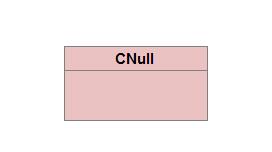
sizeof(CNull)=1,用于标识该对象。
2) 只有成员变量的类
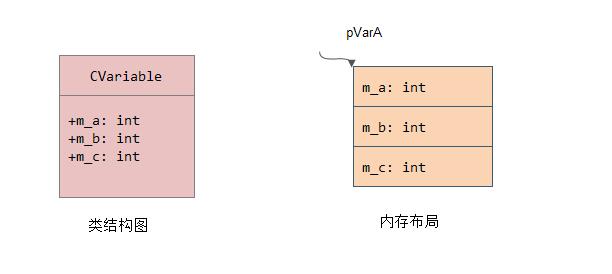
int nVarSize = sizeof(CVariable) = 12
我们用如下程序进行测试:
#include <stdio.h>
#include <stdlib.h>
class CVariable{
private:
int m_a;
int m_b;
int m_c;
};
int main(int argc,char *argv[])
{
CVariable pVarA;
printf("&pVarA: %p\n", &pVarA);
printf("sizeof(CVariable): %d\n", sizeof(CVariable));
return 0x0;
}编译运行:
# gcc -g -o test test.cpp -lstdc++
# gdb ./test
(gdb) p pVarA
$1 = {m_a = -8096, m_b = 32767, m_c = 0}
(gdb) p &pVarA
$2 = (CVariable *) 0x7fffffffdf70
(gdb) p &pVarA.m_a
$3 = (int *) 0x7fffffffdf70
(gdb) p &pVarA.m_b
$4 = (int *) 0x7fffffffdf74
(gdb) p &pVarA.m_c
$5 = (int *) 0x7fffffffdf78
3) 只有虚函数的类
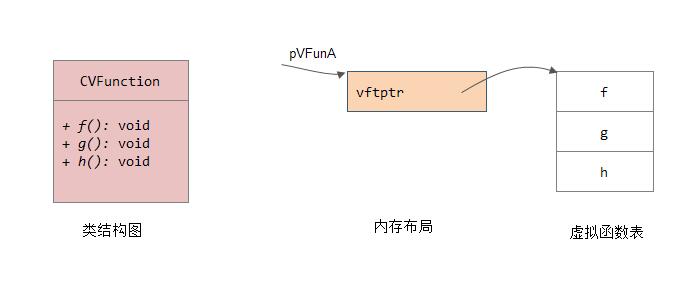
int nVFuntionSize = sizeof(CVFuction) = 8(虚表指针)
我们通过如下程序测试:
#include <stdio.h>
#include <stdlib.h>
#include <sys/types.h>
#include <stdint.h>
class CVFunction{
public:
virtual void f(){ printf("f()\n"); }
virtual void g(){ printf("g()\n"); }
virtual void h(){ printf("h()\n"); }
};
int main(int argc,char *argv[])
{
CVFunction pVFunc;
uintptr_t **p = (uintptr_t **)&pVFunc;
typedef void (*pvirtualfunc)(CVFunction *);
printf("sizeof(CVFuncation): %d\n", sizeof(CVFunction));
pvirtualfunc func1 = (pvirtualfunc)**p;
func1(&pVFunc);
pvirtualfunc func2 = (pvirtualfunc)(*(*p + 1));
func2(&pVFunc);
pvirtualfunc func3 = (pvirtualfunc)(*(*p + 2));
func3(&pVFunc);
return 0x0;
}编译运行:
# gcc -g -o test test.cpp -lstdc++ # ./test sizeof(CVFuncation): 8 f() g() h()
4) 有成员变量、虚函数的类
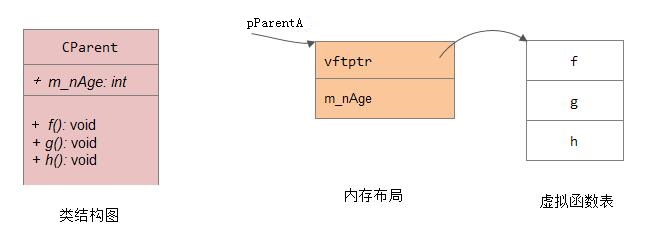
int nParentSize = sizeof(CParent) = 16 (找出最大长度的成员长度M(结构体的长度一定是该成员的整数倍))
我们通过如下程序测试:
#include <stdio.h>
#include <stdlib.h>
#include <sys/types.h>
#include <stdint.h>
class CParent{
private:
int m_nAge;
public:
virtual void f0(){ printf("f0()\n"); }
virtual void g0(){ printf("g0()\n"); }
virtual void h0(){ printf("h0()\n"); }
};
int main(int argc,char *argv[])
{
CParent pParentA;
uintptr_t **p = (uintptr_t **)&pParentA;
typedef void (*pvirtualfunc)(CParent *);
printf("sizeof(CParent): %d\n", sizeof(CParent));
pvirtualfunc func1 = (pvirtualfunc)**p;
func1(&pParentA);
pvirtualfunc func2 = (pvirtualfunc)(*(*p + 1));
func2(&pParentA);
pvirtualfunc func3 = (pvirtualfunc)(*(*p + 2));
func3(&pParentA);
return 0x0;
}编译运行:
# gcc -g -o test test.cpp -lstdc++ # ./test sizeof(CParent): 16 f0() g0() h0()
3.2 单一继承
这里介绍一下单一继承情况下的内存模型(含成员变量、虚函数、虚函数覆盖):
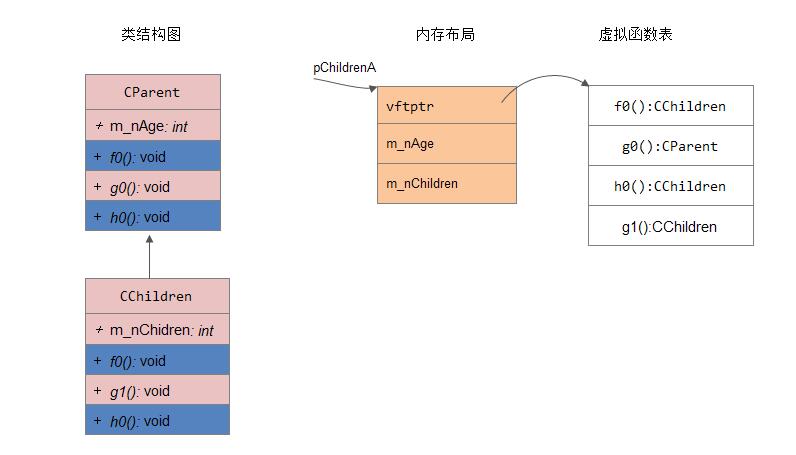
int nChildSize = sizeof(CChildren) = 16
我们通过如下程序进行测试:
#include <stdlib.h>
#include <sys/types.h>
#include <stdint.h>
class CParent{
private:
int m_nAge;
public:
virtual void f0(){ printf("f0()\n"); }
virtual void g0(){ printf("g0()\n"); }
virtual void h0(){ printf("h0()\n"); }
};
class CChildren : public CParent{
private:
int m_nChildren;
public:
virtual void f0(){ printf("children f0()\n"); }
virtual void g1(){ printf("g1()\n"); }
virtual void h0(){ printf("children h0()\n"); }
};
int main(int argc,char *argv[])
{
CChildren pChildrenA;
uintptr_t **p = (uintptr_t **)&pChildrenA;
typedef void (*pvirtualfunc)(CChildren *);
printf("sizeof(CChildren): %d\n", sizeof(CChildren));
pvirtualfunc func1 = (pvirtualfunc)**p;
func1(&pChildrenA);
pvirtualfunc func2 = (pvirtualfunc)(*(*p + 1));
func2(&pChildrenA);
pvirtualfunc func3 = (pvirtualfunc)(*(*p + 2));
func3(&pChildrenA);
pvirtualfunc func4 = (pvirtualfunc)(*(*p + 3));
func4(&pChildrenA);
return 0x0;
}编译运行:
# gcc -g -o test test.cpp -lstdc++ # ./test sizeof(CChildren): 16 children f0() g0() children h0() g1()
3.2 多继承
这里介绍一下多继承情况下的内存模型(含成员变量、虚函数、虚函数覆盖):

int nChildSize = sizeof(CChildren) = 32
我们通过如下程序进行测试:
#include <stdio.h>
#include <stdlib.h>
#include <sys/types.h>
#include <stdint.h>
class CParent1{
private:
int m_nParent1;
public:
virtual void f0(){ printf("f0()\n"); }
virtual void g0(){ printf("g0()\n"); }
virtual void h0(){ printf("h0()\n"); }
};
class CParent2{
private:
int m_nParent2;
public:
virtual void f1(){ printf("f1()\n"); }
virtual void g1(){ printf("g1()\n"); }
virtual void h1(){ printf("h1()\n"); }
};
class CChildren : public CParent1, public CParent2{
private:
int m_nChildren;
public:
virtual void f0(){ printf("children f0()\n"); }
virtual void g1(){ printf("children g1()\n"); }
virtual void f2(){ printf("children f2()\n"); }
virtual void h0(){ printf("children h0()\n"); }
virtual void h1(){ printf("children h1()\n"); }
virtual void h2(){ printf("children h2()\n"); }
};
int main(int argc,char *argv[])
{
CChildren pChildrenA;
uintptr_t **p = (uintptr_t **)&pChildrenA;
typedef void (*pvirtualfunc)(CChildren *);
printf("sizeof(CChildren): %d\n", sizeof(CChildren));
pvirtualfunc func1 = (pvirtualfunc)**p;
func1(&pChildrenA);
pvirtualfunc func2 = (pvirtualfunc)(*(*p + 1));
func2(&pChildrenA);
pvirtualfunc func3 = (pvirtualfunc)(*(*p + 2));
func3(&pChildrenA);
pvirtualfunc func4 = (pvirtualfunc)(*(*p + 3));
func4(&pChildrenA);
pvirtualfunc func5 = (pvirtualfunc)(*(*p + 4));
func5(&pChildrenA);
pvirtualfunc func6 = (pvirtualfunc)(*(*p + 5));
func6(&pChildrenA);
pvirtualfunc func7 = (pvirtualfunc)(*(*p + 6));
func7(&pChildrenA);
printf("===============================\n");
char *q = (char *)&pChildrenA;
q = q + 8 + 4 +4;
p = (uintptr_t **)q;
pvirtualfunc func8 = (pvirtualfunc)**p;
func8(&pChildrenA);
return 0x0;
}编译运行:
# gcc -o test test.cpp -lstdc++ # ./test sizeof(CChildren): 32 children f0() g0() children h0() children g1() children f2() children h1() children h2() =============================== f1()
3.3 深度为2的继承
这里介绍一下深度为2的继承情况下的内存模型(含成员变量、虚函数、虚函数覆盖):
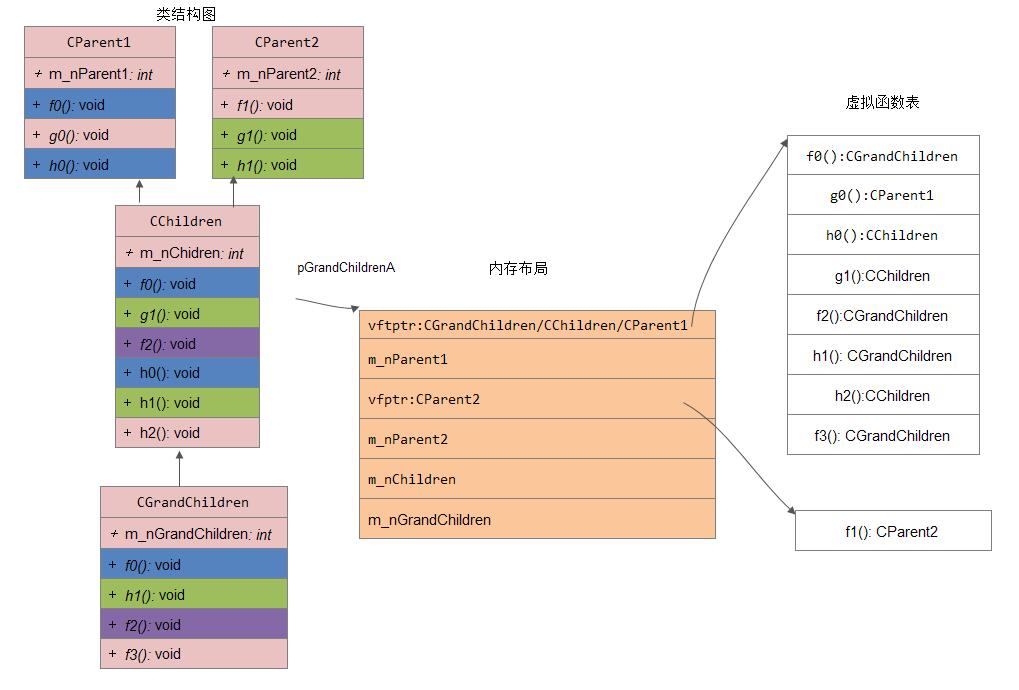
int nGrandSize = sizeof(CGrandChildren) = 40
我们通过如下程序进行测试:
#include <stdio.h>
#include <stdlib.h>
#include <sys/types.h>
#include <stdint.h>
class CParent1{
private:
int m_nParent1;
public:
virtual void f0(){ printf("f0()\n"); }
virtual void g0(){ printf("g0()\n"); }
virtual void h0(){ printf("h0()\n"); }
};
class CParent2{
private:
int m_nParent2;
public:
virtual void f1(){ printf("f1()\n"); }
virtual void g1(){ printf("g1()\n"); }
virtual void h1(){ printf("h1()\n"); }
};
class CChildren : public CParent1, public CParent2{
private:
int m_nChildren;
public:
virtual void f0(){ printf("children f0()\n"); }
virtual void g1(){ printf("children g1()\n"); }
virtual void f2(){ printf("children f2()\n"); }
virtual void h0(){ printf("children h0()\n"); }
virtual void h1(){ printf("children h1()\n"); }
virtual void h2(){ printf("children h2()\n"); }
};
class CGrandChildren: public CChildren{
private:
int m_nGrandChildren;
public:
virtual void f0(){ printf("grand children f0()\n"); }
virtual void h1(){ printf("grand children h1()\n"); }
virtual void f2(){ printf("grand children f2()\n"); }
virtual void f3(){ printf("grand children f3()\n"); }
};
int main(int argc,char *argv[])
{
CGrandChildren pGrandChildrenA;
uintptr_t **p = (uintptr_t **)&pGrandChildrenA;
typedef void (*pvirtualfunc)(CGrandChildren *);
printf("sizeof(CGrandChildren): %d\n", sizeof(CGrandChildren));
pvirtualfunc func1 = (pvirtualfunc)**p;
func1(&pGrandChildrenA);
pvirtualfunc func2 = (pvirtualfunc)(*(*p + 1));
func2(&pGrandChildrenA);
pvirtualfunc func3 = (pvirtualfunc)(*(*p + 2));
func3(&pGrandChildrenA);
pvirtualfunc func4 = (pvirtualfunc)(*(*p + 3));
func4(&pGrandChildrenA);
pvirtualfunc func5 = (pvirtualfunc)(*(*p + 4));
func5(&pGrandChildrenA);
pvirtualfunc func6 = (pvirtualfunc)(*(*p + 5));
func6(&pGrandChildrenA);
pvirtualfunc func7 = (pvirtualfunc)(*(*p + 6));
func7(&pGrandChildrenA);
pvirtualfunc func8 = (pvirtualfunc)(*(*p + 7));
func8(&pGrandChildrenA);
printf("=============================\n");
char *q = (char *)&pGrandChildrenA;
q = q + 8 + 4 + 4;
p = (uintptr_t **)q;
pvirtualfunc func9 = (pvirtualfunc)**p;
func9(&pGrandChildrenA);
return 0x0;
}编译运行:
# gcc -o test test.cpp -lstdc++ # ./test sizeof(CGrandChildren): 40 grand children f0() g0() children h0() children g1() grand children f2() grand children h1() children h2() grand children f3() ============================= f1()
[参考]
-
虚函数的实现的基本原理 注: 本文在内存模型方面存在一定错误

